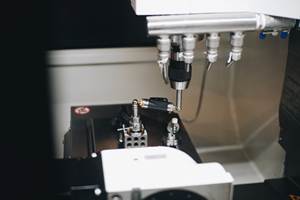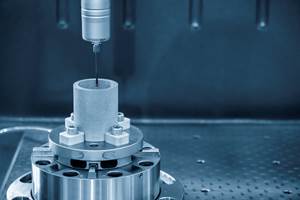Surface Finish Underfoot
Surface finish has a role in everything we see and touch.
Share





One of my colleagues has always impressed upon me that the impact of surface finish is all around us — whether it be how items look (being smooth with a shine), how well the paint covers the item, how smooth an engine performs or even how well medical implants slide against each other.
Being this is a column for machine shop manufacturing parts, we have dedicated many topics to learning how surface finish works, the need for its measurement and the various standards and parameters available for proper surface texture analysis, either with contact or optical tools. However, there is another area of a modern machine shop where the measurement and control of surface texture are beginning to make inroads. It is becoming apparent that surface texture control will affect the look and performance of a concrete floor.
Walk into any newly constructed machine shop, manufacturing facility, big box discount store or modern auto showroom, and the first thing that might strike you is how good the concrete floor looks. There are many looks, from semi- to high-gloss finishes. But there has to be a balance with the roughness of the finish to ensure they do not become slippery when dry or wet.
Until now, the flooring industry has mostly been driven by how well a floor appears — using visual tools, such as gloss meter or comparison patches, to achieve the finished product. Customers may describe a finish as honed, semi-polished, highly polished or a mirror finish. The problem is that these are highly subjective terms based on visual “feel,” and often have different impressions from one viewer to the next. I hear that millions have been lost and enormous time delays have occurred because the involved parties could not agree on the finished look of the final product.
Today, the concrete flooring industry is beginning to realize the importance of surface texture and how it impacts the look and performance of concrete flooring. The good thing about surface texture is that it is measurable, quantifiable and even traceable measuring process.
The manufacture of concrete final finish, a polishing process with different grit sizes of abrasive medium, is used to achieve a finer and finer surface. Even with concrete, this finishing process produces peaks and valleys, just as with the honing or polishing processes used in the machining industry. As such, it becomes evident that standard surface texture parameters may be used to qualify concrete floor texture.
The most common parameter for roughness measurement is Ra. Since Ra is the Arithmetic Mean roughness of the surface, it may be a viable option for quantifying the finish of the concrete. As the parameter specification notes, it measures from a mean line between the highest and lowest point on the sampling length. Thus, Ra provides the average height between the sample peaks and mid-line in qualifiable units in inches or mm.
The ideal feature of today’s surface finish equipment is their portability. Modern, handheld instruments produce lab-grade measurements anywhere they can be placed. So, they are ideal for carrying to the work site and providing test results as the process is being performed.
As various sections of the new flooring are being worked on, constant measurements can be easily made, monitoring the process and ensuring that only the time needed to achieve the results is spent, saving unnecessary finishing. Once the results are achieved, measurements can be saved as a quantifiable number, and even a trace is available as a recode of the results.
While the industry may not have completed the standardization process for using Ra surface texture as the standard for flooring qualification, it is being looked at and worked on. Maybe someday a portable surface gage will be a common tool in the concrete flooring process. Processes must be developed to determine where and how often to measure the desired results for the various finishes, and under what conditions they are made. But like so many processes in the past, unless one can standardize, quantify the results and document them, only then do they really know and understand the requirements.
Concrete flooring is just another reminder that surface finish has a role in everything we see and touch.
Related Content
Ballbar Testing Benefits Low-Volume Manufacturing
Thanks to ballbar testing with a Renishaw QC20-W, the Autodesk Technology Centers now have more confidence in their machine tools.
Read MoreThe Link Between CNC Process Control and Powertrain Warranties
Ever since inventing the touch-trigger probe in 1972, Sir David McMurtry and his company Renishaw have been focused on achieving process control over its own manufacturing operations. That journey has had sweeping consequences for manufacturing at large.
Read MoreProcess Control — Leveraging Machine Shop Connectivity in Real Time
Renishaw Central, the company’s new end-to-end process control software, offers a new methodology for producing families of parts through actionable data.
Read MoreParts and Programs: Setup for Success
Tips for program and work setups that can simplify adjustments and troubleshooting.
Read MoreRead Next
AMRs Are Moving Into Manufacturing: Considerations for Implementation
AMRs can provide a flexible, easy-to-use automation platform so long as manufacturers choose a suitable task and prepare their facilities.
Read MoreDigital Twin Provides Real-Time Feedback on Part Quality
By gathering data directly from the sensors of the CNC machine, the digital twin offered by Gemineering can identify whether a part is in tolerance and even identify the moment in the toolpath when a part fails to achieve tolerance.
Read MoreLast Chance! 2025 Top Shops Benchmarking Survey Still Open Through April 30
Don’t miss out! 91ÊÓƵÍøÕ¾ÎÛ's Top Shops Benchmarking Survey is still open — but not for long. This is your last chance to a receive free, customized benchmarking report that includes actionable feedback across several shopfloor and business metrics.
Read More






















